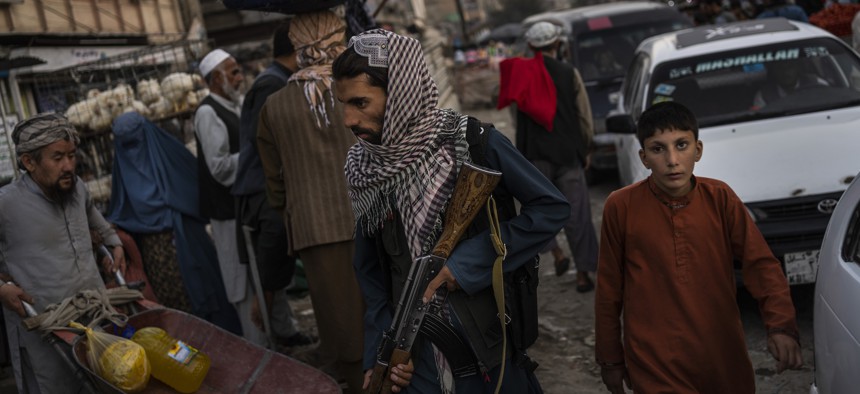
Taliban fighters patrol a market in Kabul's Old City, Afghanistan, Tuesday, Sept. 14, 2021. AP / Bernat Armangue
The Taliban PR Campaign Has Not Ended, But Transformed
Messages of liberation and inclusiveness have given way to ones that serve the consolidatation of power.
It was a slick media operation that, in the span of several years, morphed the Taliban’s public image from a movement known for sadistic executions in football stadiums into a band of young freedom fighters playing cricket in the snow. Yet, the persuasive rebranding campaign which suggested a more reasonable, more pragmatic “Taliban 2.0,” may be shifting back to “Taliban 1.0,” a new, darker phase resembling its pre-9/11 heritage. While some may suggest that the recent images of protest crackdowns, beheadings of soldiers and bearded, stone faced hardliners appointed to government positions are misunderstandings, excesses committed during a rapid takeover, or mistakes soon to be rectified, a closer examination suggests this is purposeful. Pre-takeover, the Taliban 2.0 communication objectives were to persuade internal and external audiences that the organization was reformed, liberal, patriotic and inclusive. Now they aim to intimidate, repress and control. Hardly a novel approach, this has been the playbook for totalitarian regimes throughout history.
As I argued in the Washington Post in 2019, the Taliban were able to depict themselves as patriots, legitimate negotiators, leaders committed to human rights and ready to govern with a broad-based inclusive government. They decried the corruption of the elected government and painted the military as traitors and tools of the occupiers. The “2.0” communications strategy had four main objectives: first, to erode the people’s faith in the government to rule honestly and provide security; second, to erode the morale of the Afghan forces by pushing a narrative that presented the Taliban as militarily undefeatable; third, to declare that a Taliban takeover was inevitable in the wake of the Doha agreement; and last, to rebrand themselves as a more moderate and reformed movement which would govern transparently and inclusively as well as respect human rights. This all proved catnip to the Afghan people and an international community desperate to withdraw, and terrifying to the Afghan security forces. The collapse of the Afghan military, quickly followed by a bloodless takeover of the government, were in no small part due to this effective strategy.
On Aug. 17, Zabiullah Mujahid, the heretofore faceless Taliban spokesman with more than 300,000 Twitter followers, gave his first in-person press conference. Sitting behind a podium and facing dozens of microphones, Zabiullah promised the world that the Taliban would respect women’s rights and extend a pardon to “all those who fought against us.”
Scarcely a month later, the Taliban appear to be reneging on nearly every pledge to Afghans and the international community. Despite repeated assurances by erudite spokesmen such as Zabiullah and the Doha-based Suhail Shaheen, the newly formed Taliban administration is anything but broad-based and inclusive, nor have they shown any interest in maintaining even the most basic civil liberties. With reports of women being whipped, and civilian executions, the carefully crafted image of Taliban 2.0 is increasingly showing cracks. The international community, still reeling from the harrowing evacuation scenes and grappling with the outpouring of refugees, helplessly watches from afar and voices “concerns,” proclaiming “conditions” and announcing that “they will be measured by actions, not words.”
But the international community needs to be careful. Interpreting the recent bumbling, clumsy public image as a sign that the Taliban no longer is concerned about its image, or that hard-liners have pushed aside the team who created the vision of Taliban 2.0, is done at its peril.
As the Taliban consolidated control over the country, either by force or through negotiation, the need for gentle persuasion has been replaced by a need for unquestioned subjugation to Taliban authority. The new campaign sees no need for persuasive images or reasonable social media messages as the objective is no longer to influence or convince. The message of liberation and inclusiveness during the struggle is irrelevant and the fundamental need to consolidate power is the new objective.
In this case, the post-takeover communications strategy targets the same internal and foreign audiences, but the messages and objectives are dramatically different—and not dissimilar to pre-9/11 Taliban objectives.
This new communications strategy has five major objectives: first, to impose control; second, to demonstrate the power to quash any armed resistance from former military or opposition movements; third, to pronounce new social norms throughout Afghan society; fourth, to limit speech and demonstrations except that which amplifies the new status quo; and fifth, to coerce the international community to accept the new realities. So far, the Taliban seem to be succeeding.
It would be perilous for the international community to delude itself into believing that the Taliban are malleable to influence or susceptible to persuasion. Secretary Antony Blinken may believe that the Taliban seek external legitimacy and support, but there are no signs to date that the group is modifying their behavior to earn that legitimacy. Others may believe that the post-takeover images of killings and beatings, and the repressive policies that strip away hard-earned rights of the past 20 years, are merely “mistakes” or “excesses of the transition period.” But one can take little solace from the historical records of totalitarian victories. Whether the 1917 Russian Revolution, the 1949 Chinese Revolution, the 1996 takeover of Afghanistan by the Taliban, or scores of other takeovers, coups and revolutions, it is the rare one that produces a moderate, inclusive government that respects free speech, human rights, and protection of minorities. That may have been the PR campaign of Taliban 2.0, but the current communications campaign suggests quite the opposite.
Tanya Goudsouzian is a Canadian journalist who has covered Iraq and Afghanistan for over fifteen years, and is former opinion editor of Al Jazeera English Online. Follow her on Twitter @tgoudsouzian.



